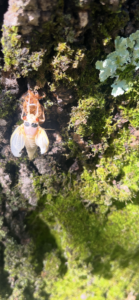 I never dreamed I’d be writing two columns about cicadas in less than a year, but here we are.
I never dreamed I’d be writing two columns about cicadas in less than a year, but here we are.
Last June, I wrote these words in this newspaper: “At my advanced age, I may not be around to see another cicada invasion.” Little did I know that, in 2025, Tennessee and other states would experience the emergence of Brood XIV, an entirely different species than 2024’s Brood XIX. This year’s cicadas are considered “near threatened” by the International Union for Conservation of Nature. They haven’t been above ground since 2008 and won’t be back until 2042. Crazy, right?
All together, the United States has seven different species of periodical cicadas. Some emerge every seventeen years, others—like Brood XIX–every thirteen.
I’m hoping for a more intense cicada experience this year than last, when they invaded the Cookeville city limits by the millions but were barely a blip on the screen east of town where I live. In 2024, no cicadas landed in my hair or on my clothes. They didn’t cover the trunks of my trees or the tires of my car or the bricks on my chimney. But from the sound of this year’s chorus, which started just a few days ago, things might be livelier this year.
So far, the cicadas’ noise is a subdued melodic thrumming that in no way makes me want to stick my fingers in my ears and run screaming into the house. It’s definitely not deafening. Not yet anyway. The music-making works like this: male cicadas congregate in choral groups near the spot where they emerged from the ground and sing to attract females. They sometimes pause to take short flights in search of willing girlfriends. Whether they find any or not, they soon return to the group and resume singing.
Though both male and female cicadas can mate multiple times, females seldom do. Once a female becomes pregnant, she’ll find a safe place on the stem of a tree or woody plant to lay her eggs. Her work above ground is done. Those eggs remain where they were laid until late summer, when the nymphs hatch, fall to the ground and burrow down for a seventeen year nap.
Then the cycle begins again.
Last weekend, I visited my kiddos in Kentucky. The cicadas really put on a show. In a big ash tree in the front yard, we discovered a fully-in-progress entomology lesson. We saw cicadas who had climbed the tree trunk and were just beginning to emerge from their shells. We saw cicadas who were all the way out of the shell all but whose still-white wings were damp and wrinkled. We saw others whose wings had flattened and darkened and dried and who would soon be ready to fly. We saw countless cicadas flitting around and countless cicadas dead on the pavement.
Cicadas are particularly vulnerable during their first week of life, when they’re easy prey for reptiles, birds, squirrels, cats, dogs and other mammals. But as millions and millions begin to emerge all at once, “predator satiation” occurs. There are far too many cicadas for predators to eat or for humans to squash, either accidentally or on purpose. So for a few blessed weeks, the cicadas sing. They fly around. They pose for photos on walls and fence posts and picnic tables. They mate and lay eggs. By the end of June, they’ll all be dead.
Which is either wonderful or sad, depending on how you look at it.
I considering it amazing. Astonishing. Miraculous. It’s enough to make me grateful I don’t live in a part of the country that doesn’t have cicadas. (There are no periodical cicadas north or west of the Texas panhandle.) The cicadas give me something to look forward to when I’m 82 and then again when I’m 87.
Assuming we haven’t completely wrecked our planet by then.
(May 24, 2025)